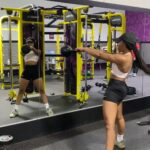Are you wondering “how much should I exercise to get fit?” Many people want to improve their fitness, but it can be difficult to know where to start. In this article, we will explore the importance of exercise for overall fitness and well-being. Understanding the role of physical activity in achieving your fitness goals is crucial, and we will discuss how different types of exercise, frequency, duration, and intensity can all impact your fitness journey.
Physical activity is essential for maintaining a healthy lifestyle and preventing chronic diseases. Exercise not only helps to improve cardiovascular health but also plays a significant role in managing weight, reducing stress levels, and improving mental well-being. With so many benefits associated with regular physical activity, it’s important to understand how much exercise is needed to achieve optimal fitness.
In the following sections, we will delve into setting realistic fitness goals based on individual needs, understanding different types of exercises such as cardio, strength training, and flexibility workouts. We will also discuss the ideal frequency and duration of workouts as well as how to gauge the appropriate intensity for your fitness level. Join us as we explore how you can create a sustainable workout routine that aligns with your personal needs and helps you achieve long-term fitness success.
Setting Fitness Goals
Evaluating Your Current Fitness Level
Before setting your fitness goals, it’s important to assess your current fitness level. This can include evaluating your cardiovascular endurance, strength, flexibility, and overall physical health. By understanding where you are starting from, you can better determine what areas you need to focus on and set realistic and achievable fitness goals.
Identifying Your Fitness Objectives
When setting fitness goals, it’s important to identify what you want to achieve through exercise. Whether it’s weight loss, muscle gain, improved endurance, or simply maintaining overall health and wellness, having clear objectives will help guide your workout routine. By knowing what you want to accomplish, you can tailor your exercise plan to align with those specific goals.
Considering Lifestyle Factors
In addition to specific fitness objectives, it’s important to consider lifestyle factors when setting fitness goals. Factors such as work schedule, family responsibilities, and other time commitments can impact how often and how long you can realistically dedicate to exercise. By taking these factors into account when setting your goals, you can create a workout plan that fits seamlessly into your lifestyle.
By understanding your personal fitness needs and considering these key factors when setting fitness goals, you can create a customized workout plan that is tailored to help you achieve long-term success in your fitness journey.
Types of Exercise
When it comes to getting fit, incorporating a variety of exercises into your routine is essential. This includes focusing on three main types of exercise: cardio, strength training, and flexibility. Cardio exercises, such as running, cycling, or swimming, are important for improving cardiovascular health and burning calories. They also help to increase endurance and stamina, making daily activities easier to handle.
Strength training is another crucial component of a well-rounded fitness routine. This type of exercise involves using resistance to build and tone muscle. It can be done with free weights, machines, resistance bands, or even just using body weight exercises. Strength training not only helps to increase muscle mass and bone density but also boosts metabolism and improves overall functional strength.
In addition to cardio and strength training, flexibility exercises are also important for maintaining mobility and preventing injuries. Stretching routines that focus on the major muscle groups can improve flexibility and range of motion. Activities like yoga or Pilates are great choices for enhancing flexibility while also promoting relaxation and stress reduction. By including all three types of exercise in your fitness routine, you can achieve a balanced approach that benefits your overall health and well-being.
Frequency of Exercise
When it comes to creating a successful fitness routine, one important factor to consider is the frequency of exercise. The question of how often you should work out depends on various factors such as your current fitness level, overall health, and personal fitness goals. Understanding your body’s needs and limitations is crucial in determining the right workout frequency for you.
For beginners or those who are just starting their fitness journey, it is recommended to aim for at least 3-4 days of exercise per week. This allows your body to adjust to the physical demands of working out while also giving it enough time to rest and recover. As you progress and build up your stamina and strength, gradually increasing the frequency of your workouts can be beneficial.
On the other hand, more seasoned fitness enthusiasts may benefit from working out 5-6 days a week, combining different types of exercises to target various muscle groups and enhance overall physical conditioning. It’s important to listen to your body and recognize signs of fatigue or overtraining, as pushing yourself too hard without sufficient rest can lead to burnout or injury.
Ultimately, finding the right frequency for exercise involves a balance between challenging your body enough to see progress while allowing for adequate rest periods. Whether you choose to work out several times a week or incorporate daily physical activity into your routine, consistency is key in achieving long-term fitness success.
Duration of Exercise
When it comes to exercise, one of the common questions that many people have is about the duration of their workouts. Determining the length of your workouts is important for achieving your fitness goals while also ensuring that you are not overexerting yourself. The duration of exercise can vary depending on the type of workout and your personal fitness level.
Cardio Workouts
For cardiovascular exercises such as running, cycling, or swimming, the general recommendation is to aim for at least 150 minutes of moderate-intensity aerobic activity per week. This can be broken down into 30 minutes a day for five days a week. If you prefer more vigorous activities, then aiming for 75 minutes per week can be sufficient.
Strength Training
When it comes to strength training, the duration of your workouts will depend on factors such as the number of muscle groups you are targeting and the intensity of the exercises. Aiming for 20-30 minutes of strength training exercises two to three times a week can be effective in building muscle and improving overall fitness.
Flexibility Workouts
Incorporating flexibility exercises such as yoga or stretching into your fitness routine can help improve range of motion and reduce the risk of injuries. Aim for at least 10-15 minutes of flexibility exercises every day or incorporate them into your warm-up and cool-down routines before and after your workouts.
Keeping in mind that everyone’s fitness journey is unique, it’s essential to listen to your body and gradually increase the duration and intensity of your workouts as you build strength and endurance. It’s also important to consult with a fitness professional or trainer to tailor a workout plan that aligns with your fitness goals while considering any physical limitations you may have.
Intensity of Exercise
When it comes to exercise, finding the right level of intensity is crucial for achieving your fitness goals. Intensity refers to how hard you are working during a workout and can vary based on factors such as age, fitness level, and overall health. Understanding the appropriate level of intensity for your personal fitness level is key to maximizing the benefits of your exercise routine.
One way to gauge exercise intensity is by using the perceived exertion scale, which rates how hard you feel like your body is working during physical activity. Another method is monitoring heart rate during exercise, as this can provide a more objective measure of intensity. Both approaches can help individuals tailor their workouts to ensure they are challenging themselves without overexerting.
It’s important for individuals to gradually increase the intensity of their workouts as their fitness level improves. Pushing too hard too soon can increase the risk of injury or burnout. By gradually progressing in terms of intensity, individuals can safely build strength, endurance, and overall fitness levels over time.
| Exercise Intensity Scale | Heart Rate Zone |
|---|---|
| Light | 50-60% of maximum heart rate |
| Moderate | 60-70% of maximum heart rate |
| Vigorous | 70-85% of maximum heart rate |
Monitoring Progress
Once you have established your fitness goals and have begun your exercise routine, it’s important to monitor your progress to ensure that you are on track to achieving your desired level of fitness. Tracking your fitness journey can provide valuable insights into the effectiveness of your exercise regimen and help you make adjustments as needed.
There are various methods for monitoring progress in fitness, including keeping a workout journal, using fitness tracking apps, and scheduling regular assessments with a personal trainer or fitness professional. Keeping a detailed record of your workouts, including the type of exercise, duration, and intensity, can help you identify trends and patterns in your performance over time.
In addition to tracking your physical activity, it’s also important to monitor other aspects of your health and wellness, such as nutrition, sleep quality, and stress levels. These factors can all impact your overall fitness and should be taken into consideration when evaluating your progress.
| Method | Description |
|---|---|
| Workout Journal | Keep a detailed record of each workout session, including exercises performed, sets and reps completed, and any notes on how you felt during the workout. |
| Fitness Tracking Apps | Use smartphone apps or wearable devices to log workouts, track daily activity levels, monitor heart rate during exercise, and set specific fitness goals. |
| Assessments with a Trainer | Schedule regular sessions with a certified personal trainer or fitness professional for body composition measurements, strength tests, flexibility assessments, and other relevant evaluations. |
The Role of Rest and Recovery in Fitness
Rest and recovery are essential components of any fitness routine. After intense physical activity, the body needs time to repair and strengthen itself. Without adequate rest and recovery, the risk of injury increases, and performance may decline. Here are some important aspects to consider when it comes to rest and recovery in fitness:
- Quality Sleep: Getting enough sleep is crucial for muscle recovery and overall physical and mental well-being. Aim for 7-9 hours of quality sleep each night to support your fitness goals.
- Active Recovery: Incorporating light, low-impact activities such as walking, yoga, or swimming on rest days can help improve blood flow and promote muscle recovery.
- Nutrition: Proper nutrition plays a key role in supporting the body’s recovery process. Consuming a balanced diet that includes protein, carbohydrates, healthy fats, vitamins, and minerals can aid in muscle repair and replenish energy stores.
It’s important to listen to your body and recognize when it needs a break. Overtraining can lead to burnout, decreased performance, and increased risk of injury. Make sure to build rest days into your exercise routine and pay attention to any signs of fatigue or overexertion.
In addition to rest, incorporating techniques such as stretching, foam rolling, or massage therapy can help release tension in muscles and improve flexibility. Remember that rest is not just about physical recovery but also mental rejuvenation. Taking time for relaxation activities such as meditation or deep breathing exercises can contribute to overall well-being and enhance the effectiveness of your fitness journey.
Expert Tips for Achieving Fitness Goals
When it comes to achieving fitness goals, getting expert tips can make a significant difference in your journey towards better health. Here are some valuable expert tips for achieving fitness goals:
- Consult a fitness professional: Before starting any exercise regimen, it’s crucial to consult with a fitness professional. They can assess your current fitness level, help you set realistic goals, and create a personalized workout plan tailored to your needs.
- Focus on consistency: Consistency is key when it comes to achieving your fitness goals. It’s better to exercise regularly at a moderate intensity than sporadically at a high intensity. Aim for at least 150 minutes of moderate-intensity exercise per week.
- Combine different types of exercise: Incorporating a mix of cardio, strength training, and flexibility exercises into your workout routine can help you achieve overall fitness and prevent boredom. Variety also helps in preventing overuse injuries and keeps the workouts interesting.
Additionally, here are more expert tips for achieving fitness goals:
- Listen to your body: Pay attention to how your body responds to exercise. If you experience pain or discomfort, it’s essential to rest and seek guidance from a healthcare professional or physical therapist.
- Stay hydrated and eat well: Proper nutrition and hydration are crucial components of any effective fitness plan. Fueling your body with the right nutrients will help support your workouts and aid in recovery.
- Get enough rest: Adequate rest is just as important as exercise itself. Allow time for muscle recovery and quality sleep to optimize the benefits of your workouts.
By following these expert tips, you can create a sustainable exercise routine that aligns with your personal fitness needs and helps you achieve long-term success in reaching your fitness goals.
Conclusion
In conclusion, achieving fitness goals requires a comprehensive understanding of personal fitness needs and a commitment to creating a sustainable exercise routine. By setting specific fitness goals, individuals can tailor their exercise regimen to include a balance of cardio, strength training, and flexibility exercises. Understanding the frequency, duration, and intensity of workouts is crucial in determining the right level for each individual’s fitness level.
Monitoring progress through tracking one’s fitness journey allows for adjustments and improvements to be made along the way. It is also important to recognize the role of rest and recovery in achieving long-term fitness success. Allowing the body adequate time to rest and recover is essential in preventing burnout and injury.
Ultimately, expert tips for achieving fitness goals emphasize the importance of consistency, motivation, and patience. Creating a sustainable exercise routine for long-term success involves finding enjoyment in physical activity and making it a priority in daily life. With dedication and perseverance, individuals can achieve their fitness goals and maintain a healthy lifestyle for years to come.
Frequently Asked Questions
How Long Does It Realistically Take to Get Fit?
The time it takes to get fit realistically varies from person to person. Factors such as starting fitness level, consistency of workouts, intensity, and diet all play a role in determining how long it will take to see results. It’s important to set realistic expectations and understand that getting fit is a gradual process that requires dedication and patience.
Is 30 Days Enough to Get Fit?
While 30 days may not be enough time to completely transform your fitness level, it can be a good start towards developing healthier habits and laying the foundation for improved fitness. In one month, you can make significant progress by consistently following a well-rounded workout routine and maintaining a balanced diet.
However, long-term fitness goals typically require more time and ongoing effort.
What Exercise Gets You the Most Fit?
The exercise that gets you the most fit is the one that you enjoy and can do consistently. There isn’t a single exercise that is universally the most effective for everyone, as individual preferences, physical abilities, and goals differ.
However, exercises that incorporate cardiovascular endurance, strength training, flexibility, and balance are typically recommended for overall fitness improvement. Finding a variety of exercises that you enjoy will help keep you motivated and committed to reaching your fitness goals.

Passionate about providing useful information to anyone with an interest in the field of Personal Training, I strive to pass on to our readers quality information and to answer any questions about Personal Trainers, the work they do and how to become one.





